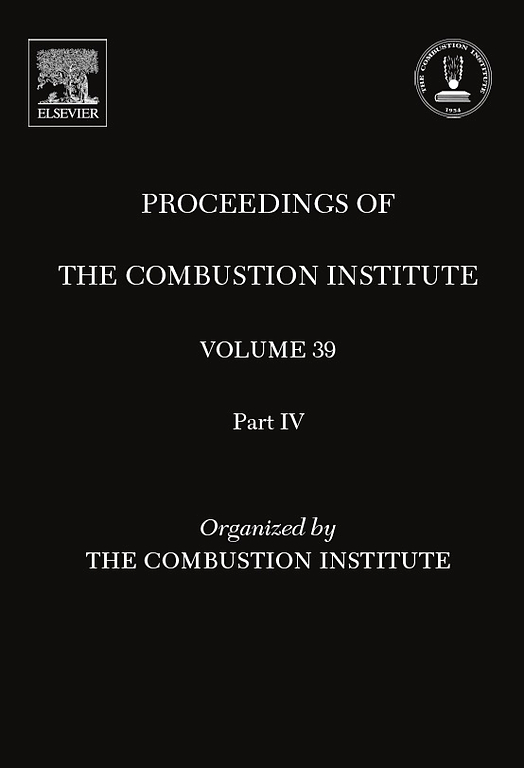松针在有限氧气和燃料水分条件下的燃烧与燃烧排放
IF 5.3
2区 工程技术
Q2 ENERGY & FUELS
引用次数: 0
摘要
使用线性管加热器装置来模拟实际野地火灾中常见的非理想燃烧情况,如有限的氧气条件。在氧气浓度介于 0% 和 21% 之间、外部热通量介于 25 kW/m 和 50 kW/m 之间的条件下,对最近的活植被燃料和死植被燃料进行了测试。利用傅立叶变换红外光谱仪(FTIR)和级联冲击器,对燃烧过程中产生的气体和微粒流出物进行了表征。结果表明,各种排放物的排放因子与氧气浓度、外部热通量和燃料含水量之间存在明显的相关性。随着氧气浓度从 0% 增加到 10%,一氧化碳和一氧化碳的排放系数(EFs)显著增加,而一氧化碳的排放系数在火焰燃烧条件下有所下降,但在烟熏条件下随着氧气浓度的进一步增加略有上升。未燃烧碳氢化合物(主要是甲烷 (CH) 和丁烷 (CH))的排放随着可用氧气的增加而增加,这是由于在较低的热通量下发生了炭氧化,具体表现为随着氧气浓度从 0% 增加到 10%,死亡燃料的碳氢化合物总排放系数从 10.71 ± 1.5 克/千克增加到 12.61 ± 3.8 克/千克,而新燃料的碳氢化合物总排放系数从 10.61 ± 1.0 克/千克增加到 14.85 ± 2.1 克/千克,增加了约 18%。还观察到,较重碳氢化合物(如丁烷)的热裂解速度加快,这是由于焚烧过程更强和氧气供应更多所致。此外,在燃烧条件下,氧气浓度的增加有利于产生氮氧化物,同时减少丙烯醛的排放。随着热通量和氧气浓度的增加,TPM 的排放量也有所减少,同时还注意到了与 PM 大小相关的化学成分差异。这项研究对建立野地燃料排放模型的工作具有重要意义,因为考虑到 FMC、供氧浓度和燃烧模式的变化,需要对排放产生的驱动过程有更广泛的了解,以便为未来的排放管理和野火管理策略提供更好的信息。本文章由计算机程序翻译,如有差异,请以英文原文为准。
Flaming vs. smoldering emissions of pine needles under limited oxygen and fuel moisture conditions
A linear tube heater apparatus was used to simulate the non-ideal burning commonly encountered in real wildland fire scenarios, such as limited oxygen conditions. Recently live and dead vegetative fuels were tested under oxygen concentrations varied between 0 and 21 % with applied external heat fluxes ranging from 25 to 50 kW/m. Utilizing Fourier-transform infrared spectrometry (FTIR) and a cascade impactor, both gaseous and particulate effluents produced during combustion were characterized. The results revealed a significant correlation between emission factors of various species and oxygen concentrations, external heat fluxes and fuel moisture contents. As oxygen concentration increased from 0 % to 10 %, emission factors (EFs) of CO and CO significantly increased, while CO EFs decreased under flaming conditions but slightly increased under smoldering conditions with further increases in oxygen concentration. Emission of unburnt hydrocarbons, predominantly methane (CH) and butane (CH), increased with additional available oxygen due to char oxidation at a lower heat flux, evidenced by an approximately 18 % rise in total hydrocarbon emission factors from 10.71 ± 1.5 to 12.61 ± 3.8 g/kg for dead fuels and 10.61 ± 1.0 to 14.85 ± 2.1 g/kg for recently live fuels as oxygen concentrations increased from 0 to 10 %. Accelerated thermal cracking in heavier hydrocarbons (i.e., butane) due to a stronger smoldering process and greater oxygen supply was also observed. Additionally, increasing oxygen concentrations favored the production of NO while reduced acrolein emissions under flaming conditions. TPM emissions reduced with higher heat flux and oxygen concentration, and the difference in chemical composition associated with PM size was noted. This study has important implications on efforts to model emissions from wildland fuels, as a broader understanding of the processes driving emissions production considering variations in FMC, oxygen supply concentration and combustion modes is needed to better inform future emission management and wildfire management strategies.
求助全文
通过发布文献求助,成功后即可免费获取论文全文。
去求助
来源期刊

Proceedings of the Combustion Institute
工程技术-工程:化工
CiteScore
7.00
自引率
0.00%
发文量
420
审稿时长
3.0 months
期刊介绍:
The Proceedings of the Combustion Institute contains forefront contributions in fundamentals and applications of combustion science. For more than 50 years, the Combustion Institute has served as the peak international society for dissemination of scientific and technical research in the combustion field. In addition to author submissions, the Proceedings of the Combustion Institute includes the Institute''s prestigious invited strategic and topical reviews that represent indispensable resources for emergent research in the field. All papers are subjected to rigorous peer review.
Research papers and invited topical reviews; Reaction Kinetics; Soot, PAH, and other large molecules; Diagnostics; Laminar Flames; Turbulent Flames; Heterogeneous Combustion; Spray and Droplet Combustion; Detonations, Explosions & Supersonic Combustion; Fire Research; Stationary Combustion Systems; IC Engine and Gas Turbine Combustion; New Technology Concepts
The electronic version of Proceedings of the Combustion Institute contains supplemental material such as reaction mechanisms, illustrating movies, and other data.
 求助内容:
求助内容: 应助结果提醒方式:
应助结果提醒方式:


